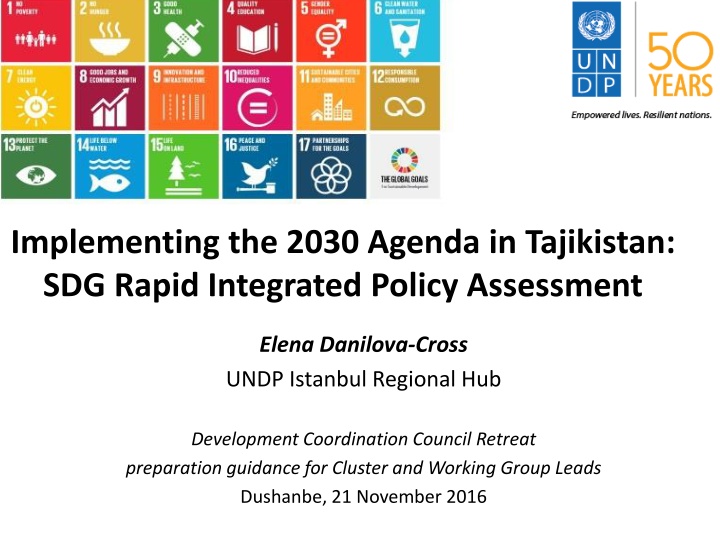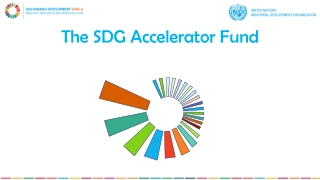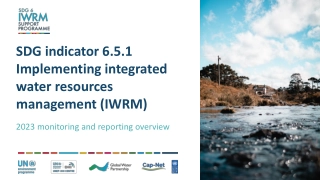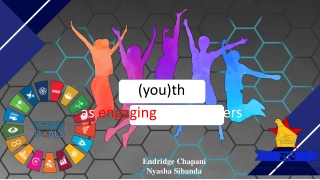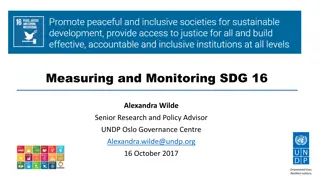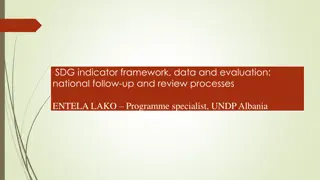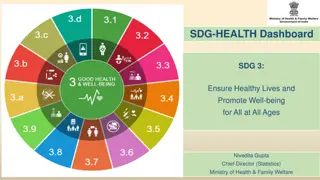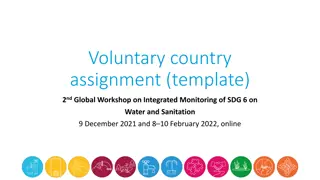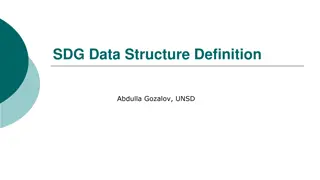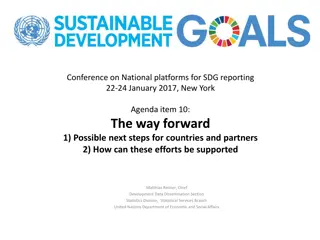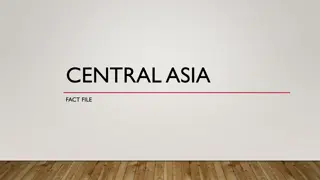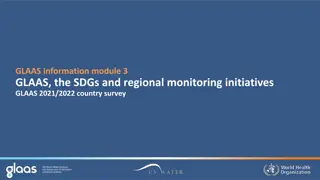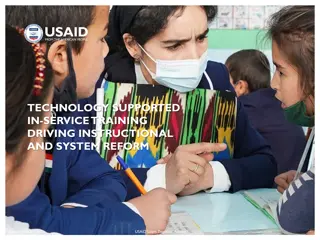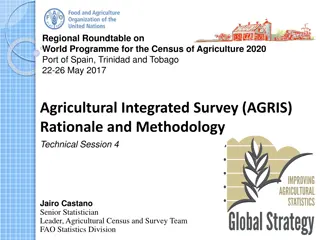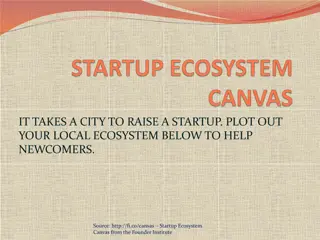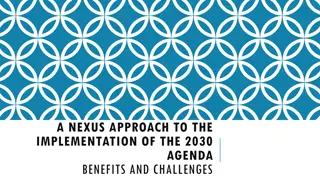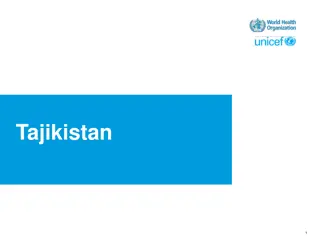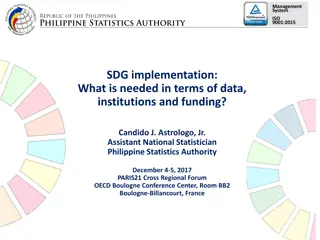Implementing the 2030 Agenda in Tajikistan: SDG Rapid Integrated Policy Assessment
Through a Rapid Integrated Policy Assessment, UNDP assessed Tajikistan's alignment with the SDGs by mapping 111 targets across various sectors. The report highlights challenges and opportunities in achieving SDG targets, including gender equality, infrastructure development, health, economic growth, and more. It emphasizes the importance of multi-sector coordination, institutional ownership, and leveraging partnerships for successful SDG implementation.
Download Presentation

Please find below an Image/Link to download the presentation.
The content on the website is provided AS IS for your information and personal use only. It may not be sold, licensed, or shared on other websites without obtaining consent from the author.If you encounter any issues during the download, it is possible that the publisher has removed the file from their server.
You are allowed to download the files provided on this website for personal or commercial use, subject to the condition that they are used lawfully. All files are the property of their respective owners.
The content on the website is provided AS IS for your information and personal use only. It may not be sold, licensed, or shared on other websites without obtaining consent from the author.
E N D
Presentation Transcript
Implementing the 2030 Agenda in Tajikistan: SDG Rapid Integrated Policy Assessment Elena Danilova-Cross UNDP Istanbul Regional Hub Development Coordination Council Retreat preparation guidance for Cluster and Working Group Leads Dushanbe, 21 November 2016
A ROADMAP TOWARD SDG IMPLEMENTATION I. Alignment: Assessing national priorities and the SDGs II. Data, monitoring, and reporting III. From planning to action: Prioritizing SDG accelerators IV. Integrating into budget frameworks V. Resources and partnerships
ALIGNMENT: MAINSTREAMING THE SDGs Coherence of national plan and SDGs? Coherence of sector and sub-national plans? Institutional arrangements: cross-sector coordination mechanisms? Rapid Integrated Assessment: mapping of SDGs against national/sub-national priorities Ensure appropriate institutional ownership Learn from the forgotten MDGs RIA reviews the current national development plans and relevant sector strategies, and provides an indicative overview of the level of alignment with the SDG targets It also identifies inter-linkages across targets The tool has been used in approximately 10 countries globally
I. Alignment: Assessing national priorities and SDGs Tajikistan RIA Methodology UNDP conducted an integrated assessment of 2 State and 8 sectoral programmes against the SDG targets Maps SDG targets (rather than goals): Identified 111 targets relevant to Tajikistan (66% of global 169 targets) Policy areas/sectors covered water, gender, environment, agriculture, health, justice, labour market
NDS 2030 alignment with SDGs INTRODUCTION CHAPTER 2: CHALLENGES AND OPPORTUNITIES SDG 5 (gender) CHAPTER 1 : Tajikistan in 2030 SDG 11 (cities) SDG 9 (infrastructure ) SDG 3 (health); SDG 8 (jobs and growth); SDG 11 (cities) SDG 13 (climate change) SDG 17 (partnerships) SDG 15 (land) CHAPTER 5: GROWTH AND REAL SECTOR CHAPTER 4: HUMAN CAPITAL CHAPTER 3: INSTUTIONAL POTENTIAL SDG 4 (education); SDG 3 (health); SDG 1 (well-being); SDG 16 (inclusive societies); SDG 6 ( Water); Goal 5 (gender); Goal 10 (inequalities); Goal 7 (energy); SDG 9 (Infrastructure) SDG 9 (infrastructure); SDG 8 (jobs and growth); SDG 17 (partnerships); SDG 1 (well-being); SDG 16 (inclusive societies); SDG 15 (Lands); SDG 4 (education) SDG 17 (partnership) SDG 10 (inequalities) CHAPTER 6: M&E SDG 17 (partnerships)
Summary of Tajikistan mapping 3-level of alignment of the SDG targets 111 SDG targets prioritized out of global 169 (68%) 1. Poverty 100 17. Partnership 2. Hunger 90 80 16. Peaceful and inclusive societies 3. Health 70 60 50 15. Lands 4. Education 40 30 20 10 14. Oceans 5. Gender 0 13. Climate change 6. Water 12. SCP 7. Energy 11. Cities 8. Growth and Jobs 10. Inequality 9. Infrastructure and industrialization
From MDGs to Agenda 2030 in Tajikistan National MDGs (2000-2015) MDG 1. Poverty and hunger (4 indicators) Global SDGs (2016-2030) SDG 1. Poverty (7 targets) SDG 2. Hunger and food security (8 targets) SDG 8. Growth and jobs (12 targets) SDG 10. Inequality (10 targets) SDG 4. Education (10 targets) SDG 5. Gender (9 targets) MDG 2. Education (3 indicators) MDG 3. Gender (3 indicators) MDG 4. Child mortality (3 indicators) MDG 5. Maternal health (2 indicators) MDG 6. HIV/AIDS, malaria, other diseases (7 ind) MDG 7. Environmental sustainability (5 indicators) SDG 3. Health (13 targets) SDG 6. Water (8 targets) SDG 7. Energy (5 targets) SDG 9. Infrastructure and industrialization (8 targets) SDG 11. Cities (10 targets) SDG 12. Sustainable consumption and production (11 targets) SDG 13. Climate change (5 targets) SDG 14. Oceans (10 targets) SDG 15. Lands (12 targets) SDG 17. Partnerships (19 targets) SDG 16. Peaceful and inclusive societies (12 targets) MDG 8. Global partnership (5 indicators)
Within SDG gap analysis (Tajikistan) SDG means of implementation : many targets not covered but often not relevant for development plans but further attention to means of implementation targets can drive SDG progress (SDG 8 (growth and jobs); SDG 10 (inequality); SDG 12 (consumption and production); SDG 13 (Climate Change); SDG 16 (inclusive societies) SDG 11 (Cities): Low coverage of 11.3 (sustainable urbanization), 11.6 ( environmental impact of cities), 11.7 (green and public spaces) SDG 12 (Growth and jobs): Gaps in 12.1 (frameworks and programmes on sustainable consumption and production), 12.3 (food losses), 12.6 (sustainability reporting), 12.7 (sustainable public procurement) . 12.8 (sustainable lifestyle) SDG 16 (inclusive societies and democratic governance): Gaps in 16.1. (reducing all forms of violence) 16.2 (abuse of children), 16.4 (combating organized crime), 16.9 (legal identity), 16.10 (public access to information)as well as lack of inclusive decision-making including local governance SDG 14 on oceans seems to be irrelevant
Cross-sectoral gap analysis (Tajikistan) Sectoral strategies with well-address cross-sectoral nature of SDGs Water Programme up to 2025 covers SDG 6 on water, SDG 1 on well being, SDG 7 on Energy, SDG 9 on infrastructure, SDG 16 on inclusive societies and SDG 17 on partnerships State Ecological program up to 2019 covers SDG 6 on water, SDG 7 on Energy, SDG 1 on poverty, SDG 2 on hunger, SDG 15 on lands, SDG 13 on climate change, SDG 12 on SCP and SDG 11 on cities Agricultural Reforms program up to 2020 is the most cross-sectoral of all: it is present in SDGs 1,2,5,6,8,12 and 13 Labour Market development strategy up to 2020 is a matter of concern it terms of having rather limited cross-sectoral presence ( only in SDGs 1,3,8 and 10), while this sector is an enabler or accelerator for lifting up many other SDGs Sector-specific strategies that are working in silos Health up to 2022 is only covering SDG 3 on health Domestic Violence up to 2023 is mostly targeting SDG 5 on gender and is also represented in SDG 1 (well-being) and SDG 3 (health)
Taking the assessment forward: Policy implementation - KAZ Putting in place a policy framework that supports SDG achievement is a critical step Policies as effective as their implementation Consider the nature of the gaps and their relevance in Kazakhstan s context; based on this, determine nationally appropriate targets Whole of government approach to attaining SDGs Minister-level cabinet member or dedicated team in charge of coordinated implementation SDG Dashboard populated with timely, policy-relevant data to facilitate aligning plans with targets; making choices on actions; and adapting policies for anticipated constraints: technological change; globalization; urbanization; demographic shifts; and for aggregate limits on development paths. Policy reforms to set incentives right for private sector to drive sustainable human development forward, e.g., carbon pricing that reflects global social/environmental costs Seize synergies from aligning national implementation with international context SDG 17.
Taking the assessment forward: ACCELERATION and Synergies - KAZ Identify enabling activities that accelerate progress across a range of SDGs Cross-sectoral solutions and data to support analysis Look beyond direct, linear, isolated effects: (i) SDGs, countries & regions interact; (ii) externalities, public goods, returns to scale can lead to market failures; (3) feedback loops set in motion can have large cumulative effects, shaping development path & requiring reoptimization Improved institutional arrangements will help achieve Goal 16 and help create favorable conditions for achieving targets of many other Goals Prioritizing the integration of Goal 5 targets on gender equality and women s empowerment addresses multiple economic and social goals Emphasis on transition to green economy, energy efficiency, water management in development planning
Source of NDS 2030 financing Total cost estimate 118.1 bln USD (in 2014 prices) Private sector, 46.3% State budget 47.5% Development partners, 6.2%
Source of NDS 2016 - 2020 financing Total cost estimate over 25.5 bln USD (in 2014 prices) State budget, 4.54, 18% Private sector, 9.96, 39% Development partners, 11, 43%
What could be the role of development partners? Coordination: Azerbaijan: inter-agency and inter-governmental SDG Taskforce to develop an SDG roadmap. NP 1 Groups are designed at 2 levels (ministerial level + technical level) Each group has representative from UNCT and relevant dev partner Each group has an NSO representative NP5 NP2 NP4 NP3 Sharing responsibilities: Georgia. Together with the UN and other development partners, Georgia is creating a digital/online platform for interactive data collection and visualization of the SDGs and nationalization process. National SDG Reporting Montenegro. High Level Political Forum voluntary review 2016: (1) human resources and strengthening social inclusion; (2) social resources (support to values, norms and behavior patterns) + Rule of Law and trust to institutions; (3) natural resources (natural capital, introduction of green economy) (4) governance for sustainable development (5) financing for sustainable development.
UNDPs contribution to SDGs in Tajikistan Monitoring and reporting aligned with SDGs The process of elaboration, implementation and M&E, and their alignment with NDS/MTDP improved SDGs are nationally adapted and operationalized Capacities of the National Development Council and MEDT supported Public awareness to promote multi- stakeholder dialogue strengthened Promotion of SDGs implementation
Thank you very much! Questions for discussions? elena.danilova-cross@undp.org
SDG COUNTRY REPORTING GUIDELINES: OUTLINE CHAPTER 1 CHAPTER 2 CHAPTER 3 CHAPTER 4 Principles Universality leaving no one behind integrated agenda and indivisible human rights National ownership Who and How to engage? Identifying relevant stakeholders Setting up platforms for engagement Leveraging IT technology Introduction Follow up and review processes: global (HLPF) regional (SDG Regional Reports) country (SDG Country Reports) Setting the scene for reporting Drivers of an inclusive process
SDG COUNTRY REPORTING GUIDELINES: OUTLINE CHAPTER 5 CHAPTER 6 CHAPTER 7 Localizing SDG targets Preparing an analytical report Communications, dissemination and advocacy Developing an advocacy plan Reaching target audiences Defining national SDG indicators (based on the global framework) Methodologies: Analytical narratives MAF Trend analysis Focus groups Microsimulation Growth dynamic Systems and economy wide modelling Setting baselines Annex: Suggested outline for a SDG Country report
